Part 1 Background
Over the past decade, the growth of the global photovoltaics (PV) industry has been impressive, with significant technological developments made in both laboratory and industrial mass production. As illustrated in Figure 1, new technologies have emerged during this period and cell efficiencies have increased rapidly. The laboratory efficiency of a monocrystalline silicon cell has reached 26.7%, with the emerging Perovskite and Si tandem cell technology reaching 29.8%.
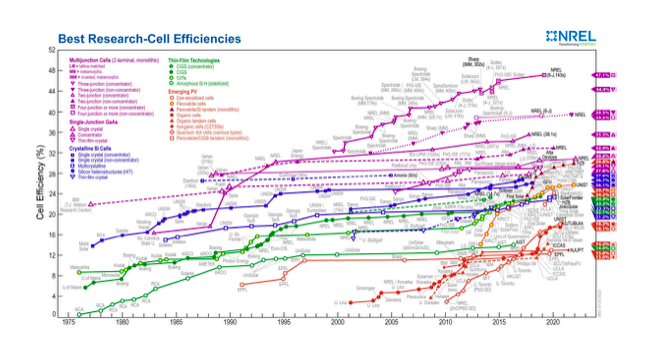
However, despite new emerging technologies, the industry’s mainstream remains monocrystalline cell technology. With the development and maturity of p-type PERC technology, there is now limited space for further efficiency improvements in this area, whereas the efficiency of n-type cells has been improving rapidly. The production capacity of n-type cells is forecast to expand over the coming 1-2 years, as maturity of the technology and related equipment develops and cost decreases. The n-type PV module is expected to become the mainstream product in the market in 5 years, as shown in Figure 2.
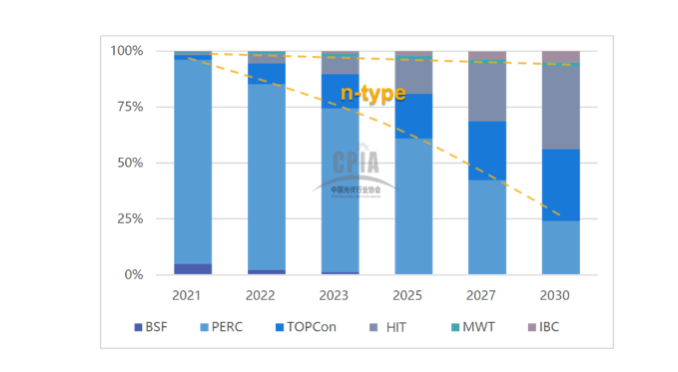
Part 2 Introduction of DeepBlue 4.0 X
JA Solar launched its DeepBlue 3.0 series products in May 2020, signalling the new era of 182 modules and DeepBlue 3.0 has now become one of the market’s mainstream products. Two years later, the company is launching a new product – DeepBlue 4.0 X. It inherits the customer-centric value of the DeepBlue series, is based on the latest n-type high-efficiency cell and module technology and will be an industry leader.
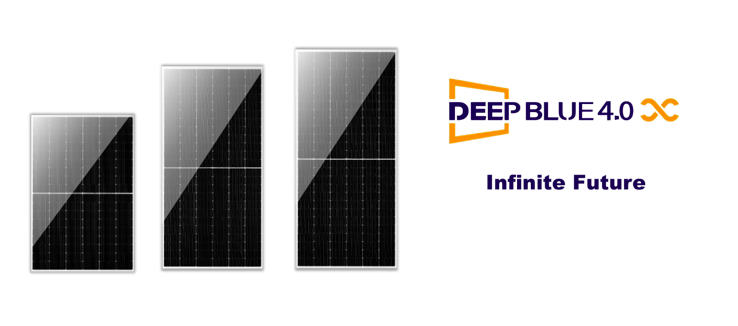
Core features and advantages of DeepBlue 4.0 X are listed below:
1. BYCIUM+ n-type high-efficiency bifacial cells
1) DeepBlue 4.0 X is JA Solar’s first official n-type product, but the company has been developing an n-type cell for 13 years. The core technologies of the high-efficiency n-type Bycium+ cell cover wafer, cell and process.Wafer for BYCIUM+ cell: the wafers are JA Solar’s own self-developed phosphorus-doped n-type wafers. Their minority carrier lifetime is much higher, at the millisecond level (over 50 times that of a p-type wafer). An n-type cell needs to go through an ultra-high temperature process. In order to eliminate the negative effects of oxygen in the high temperature environment, the oxygen content in the wafer is effectively reduced to less than 12 ppm, thus enabling the wafer to meet the requirements for n-type cells which are highly sensitive to oxygen. In terms of wafer size, JA Solar will continue with the proven M10 wafer size which has been adopted for its p-type products. This ensures that n-type module size is exactly the same as that for a p-type module, which is more convenient for subsequent module installation and application.
2) Surface passivation structure: for many years, the most effective way to enhance cell efficiency has been better surface passivation. The passivation of the front and rear surfaces of the BYCIUM+ cell has been optimally upgraded, as shown in Figure 4, with a combination of chemical and field passivation effects on both surfaces as well as an innovative passivation contact on the rear surface, enabling it to reduce surface recombination to near zero. In addition, the combination of ultra-thin fingers and double-sided anti-reflection coating has also been adopted to allow the cells to harness more light energy. The cell Voc exceeds 720mv, and mass-production efficiency is over 24.8%.
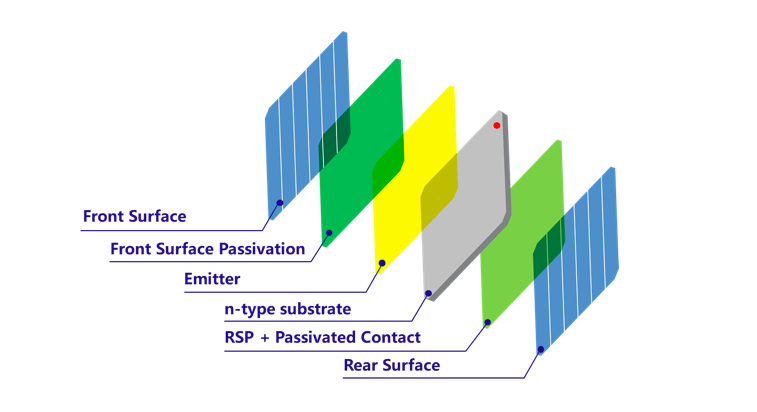
Figure 4 Structure of BYCIUM+ n-type high-efficiency bifacial cell
2. Gapless Flexible Interconnection (GFI) Technology
The advanced n-type cell technology contributes significantly to improving the efficiency of the final module product. In order to achieve higher module efficiency, DeepBlue 4.0 X also employs a new-generation high-density module technology – Gapless Flexible Interconnection (GFI). As shown in Figure 5, GFI technology eliminates the micro crack problem for high-density modules by adopting regular round ribbon together with a special buffer design which deals with mechanical stress at the cell connection point. It ensures stable and reliable long-term power generation performance. GFI is also totally compatible with both monofacial and bifacial modules and, using this technology, module power can be increased by more than 5 watts and efficiency by at least 0.2%.
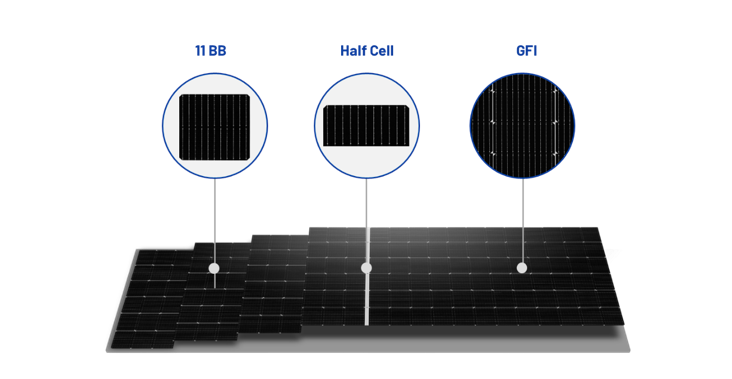
3. Excellent Reliability
IEC standards require a module power loss of below 5% after testing. As can be seen from Figure 6, the power loss of DeepBlue 4.0 X is only around 2%, demonstrating its excellent reliability and ensuring the power generation performance of the product during its 30-year lifetime.
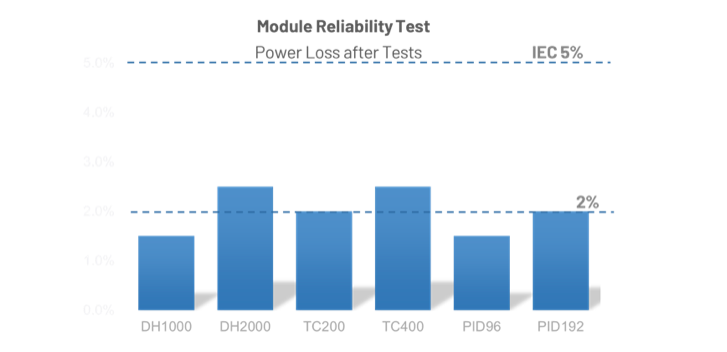
4. Higher power and efficiency
With its advanced cell and module technologies, DeepBlue 4.0 X has a higher power density. Compared with a p-type module, the power of DeepBlue 4.0 X is about 25W higher and module efficiency about 1% higher (Figure 7).
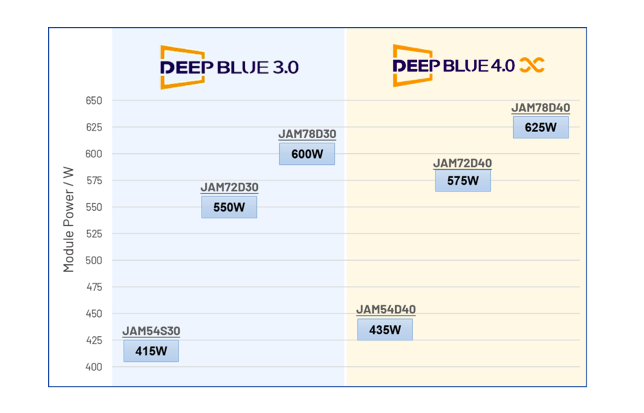
5. Lower Degradation
When evaluating a module product, in addition to power and efficiency, the module’s power generation performance is also critical, because this affects a customer’s benefits from a PV power station. Power generation performance is mainly affected by factors including degradation, temperature effect, bifaciality and low light performance.
JA Solar provides a 30-year power output warranty (Figure 8), with a first-year degradation of 1% and a linear degradation rate of 0.4% for each subsequent year. After 30 years, the power of a DeepBlue 4.0 X module can still be at least 87.4% of its original output, some 2.4% higher than a conventional p-type module. Because of this lower rate of degradation, an n-type module will generate 1.8% more electricity over 30 years than a p-type equivalent.
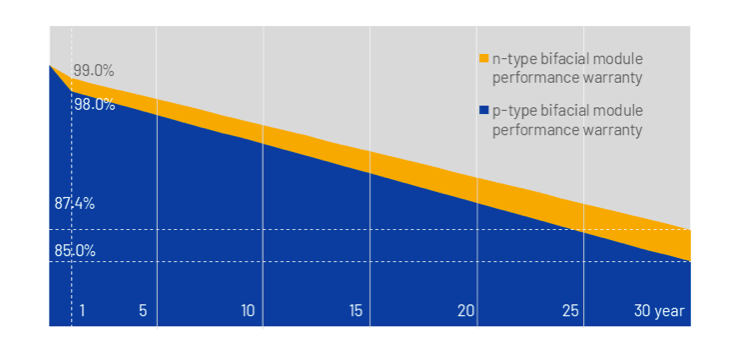
6. Lower Temperature Influence
As is common knowledge, higher temperatures will reduce the power output of a PV module. Since the BYCIUM+ cell’s open circuit voltage can be as high as 715 mV, the DeepBlue 4.0 X has a better temperature coefficient of -0.30%/°C, compared with -0.35%/°C for a p-type module. As can be seen from Figure 9, thanks to its excellent temperature coefficient, the DeepBlue 4.0 X can generate about 2% more electricity than a p-type module in one year, assuming an operating temperature of 65°C.
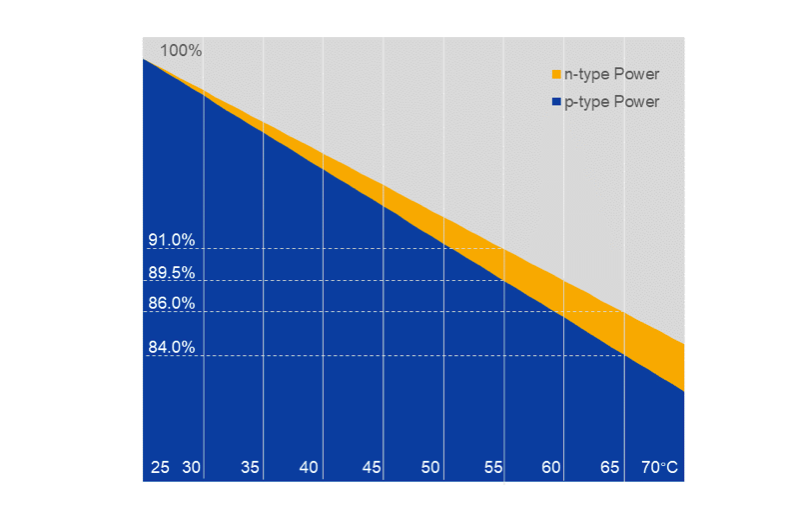
7. Higher Bifacial Benefits
Under standard illumination of 1000 W/m2, DeepBlue 4.0 X has a bifaciality of 80%, with the typical value for a p-type module only 70%. If back side irradiation is assumed to be 10% of the front side, the extra bifacial gain is about 0.9% for DeepBlue 4.0 X compared with a p-type module.
8. Better Low Light Performance
Because of the lower internal resistance and higher minority carrier lifetime of n-type cells, DeepBlue 4.0 X has a better performance under low irradiation. Test results show (Figure 10) that when irradiation is below 600 W/m², an n-type module produces more electricity than a p-type, meaning that the energy gain in the morning or evening would be about 0.2%.
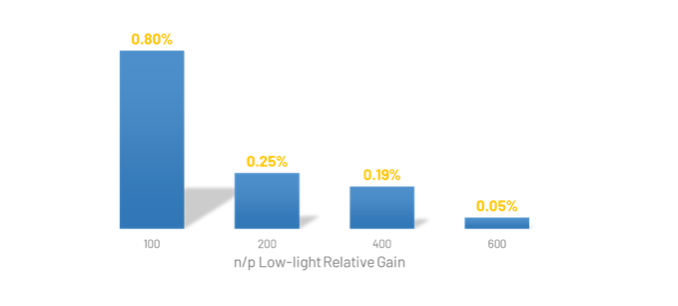
The following graphic (Figure 11) summarizes the features and benefits of the DeepBlue 4.0 X module.
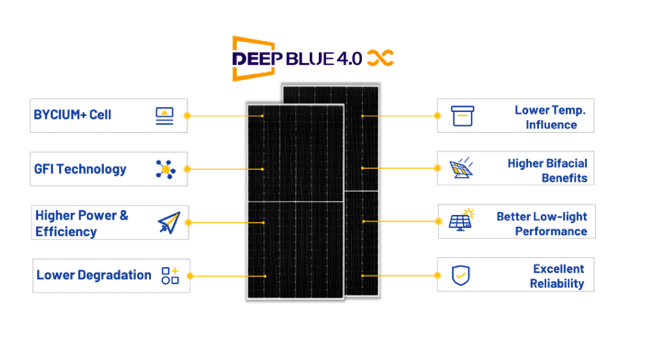
Part 3 Data from Demonstration Project and Simulation
Maximizing customer value is the core design concept of DeepBlue 4.0 X. The excellent power generation performance of an n-type module significantly improves customer value. JA Solar and TÜV Nord launched a one-year (February 2021-February 2022) energy yield test at the China Photovoltaic Test Center’s Yinchuan base in the north west of the country. The results (Figure 12) from this demonstration project show that the power generation of n-type modules is 3.9% higher than that of p-type modules.
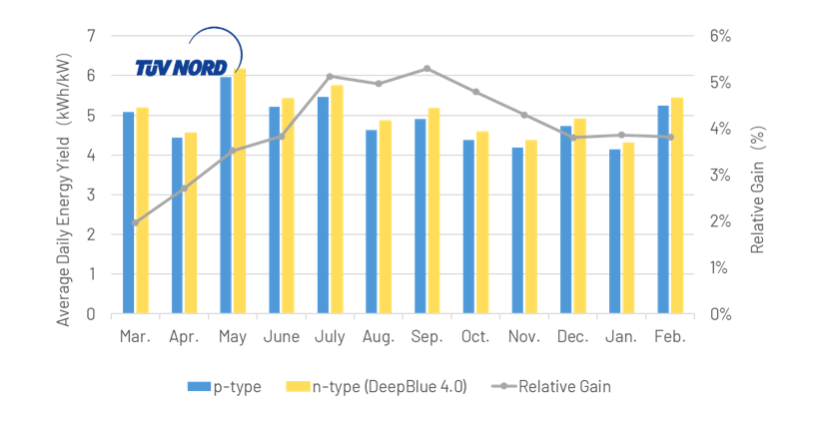
BOS and LCOE are the core indicators for assessing customer value of a PV power plant. Simulations were carried out on a 100MW project in Dubai to compare the BOS and LCOE of DeepBlue 4.0 X and a p-type module. The results show the BOS costs for DeepBlue 4.0 X were 2.1% lower and LCOE 4.6% lower than for a p-type module (Figure 13).
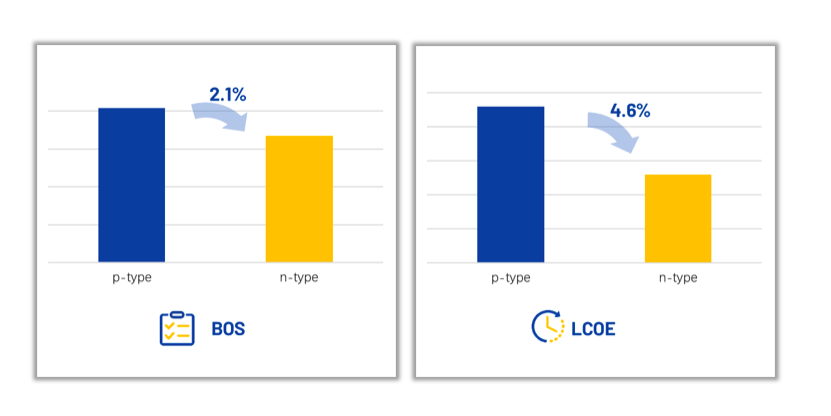
In addition, for different regions, corresponding simulations (Figure 14) showed LCOE of an n-type module to be better than that of a p-type, with an average difference of about 2.3%.
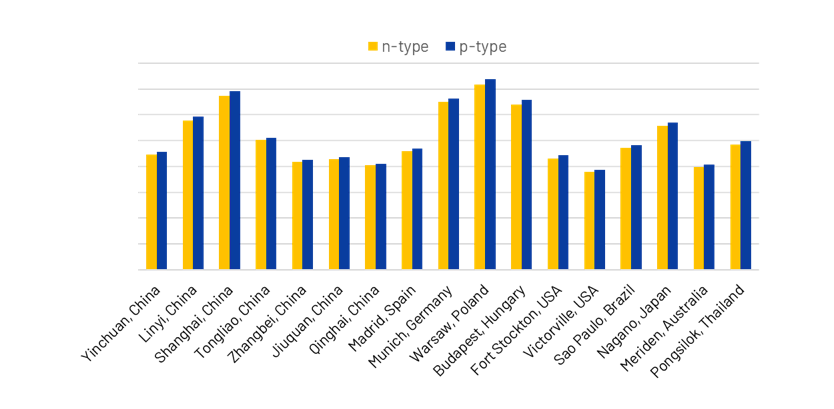
Part 4 Closing
“High quality, high efficiency, low cost” are the eternal objectives of the PV industry. The cost will directly affect large-scale commercial applications. The cell manufacturing cost of DeepBlue 4.0 X is still a little higher than that for a p-type product. However, with further improvements in technology and production capacity, we believe that the cost of DeepBlue 4.0 X will be more competitive in the next 1-2 years. Moving forward, JA Solar will continue to provide customers with PV products with the best LCOE and highest customer value and continue to contribute to the achievement of carbon neutrality goals.

